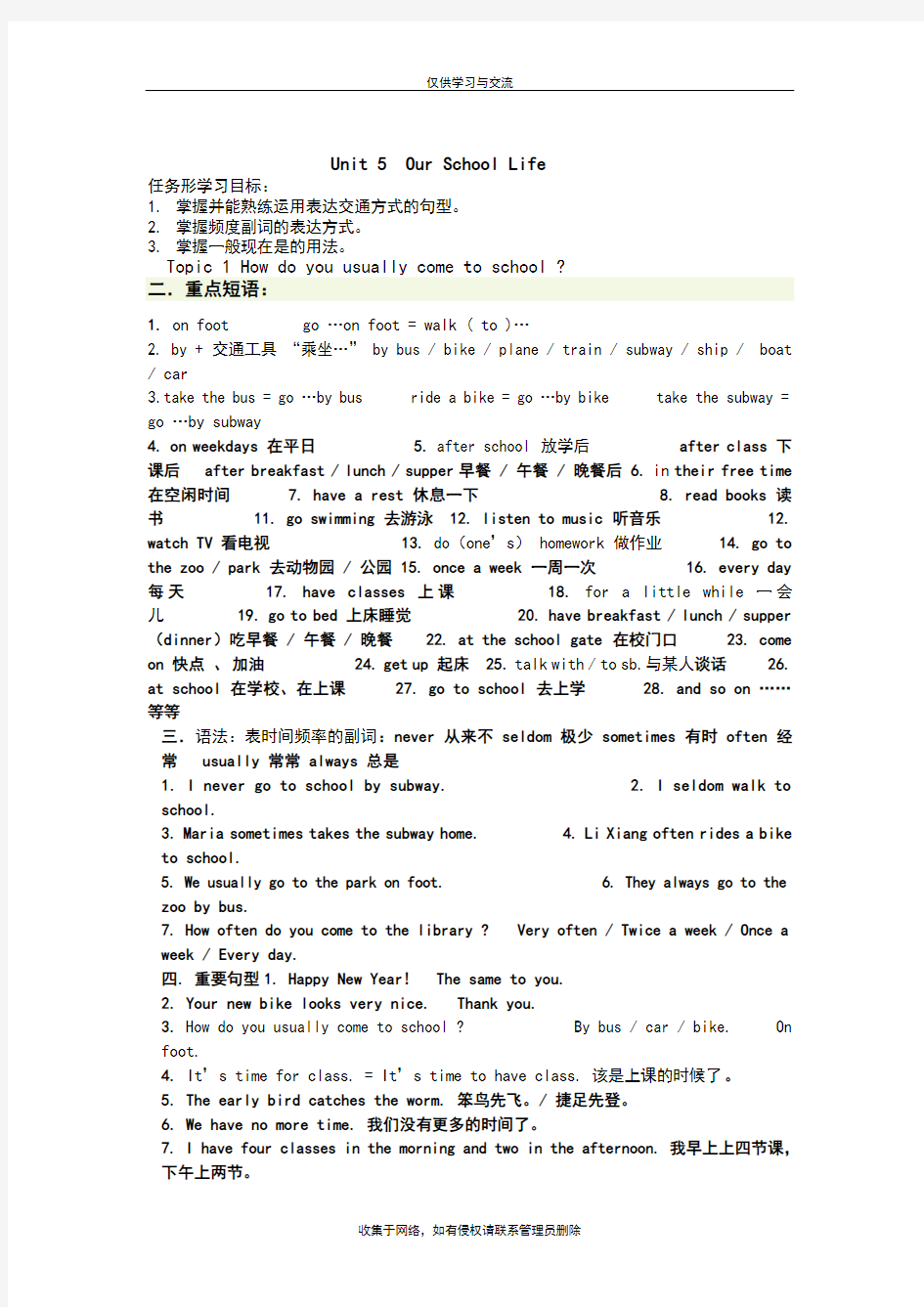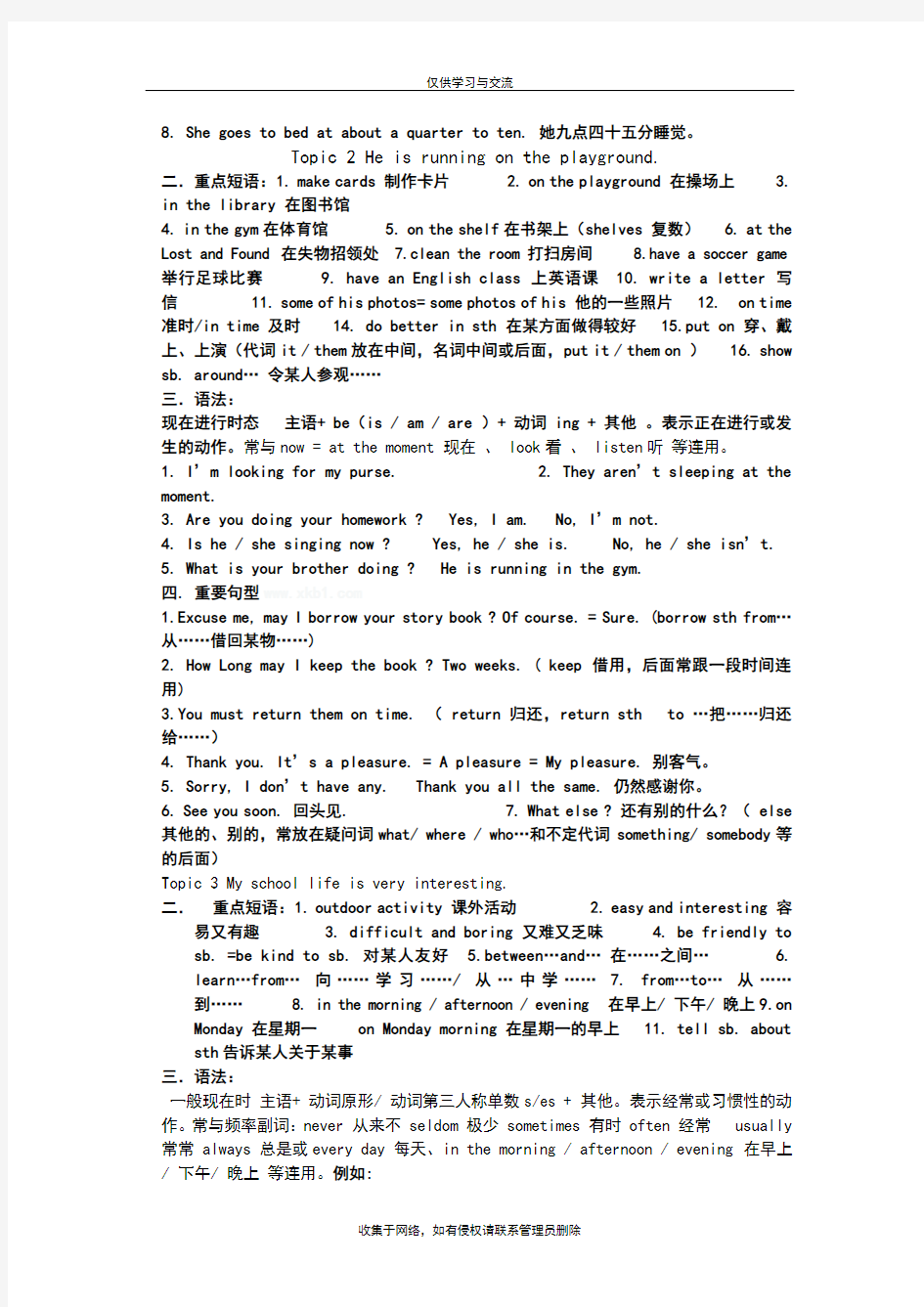最新仁爱英语七年级下册复习教案


Unit 5 Our School Life
任务形学习目标:
1.掌握并能熟练运用表达交通方式的句型。
2.掌握频度副词的表达方式。
3.掌握一般现在是的用法。
Topic 1 How do you usually come to school ?
二.重点短语:
1. on foot go …on foot = walk ( to )…
2. by + 交通工具“乘坐…” by bus / bike / plane / train / subway / ship / boat / car
3.take the bus = go …by bus ride a bike = go …by bike take the subway = go …by subway
4. on weekdays 在平日
5. after school 放学后after class 下课后 after breakfast / lunch / supper早餐 / 午餐 / 晚餐后
6. in their free time 在空闲时间
7. have a rest 休息一下
8. read books 读书11. go swimming 去游泳12. listen to music 听音乐12. watch TV 看电视13. do(one’s) homework 做作业14. go to the zoo / park 去动物园 / 公园 15. once a week 一周一次16. every day 每天17. have classes 上课18.for a little while 一会儿1
9. go to bed 上床睡觉20. have breakfast / lunch / supper (dinner)吃早餐 / 午餐 / 晚餐22. at the school gate 在校门口 23. come on 快点、加油 24. get up 起床25.talk with / to sb.与某人谈话 26. at school 在学校、在上课27. go to school 去上学 28. and so on ……等等
三.语法:表时间频率的副词:never 从来不 seldom 极少 sometimes 有时 often 经常 usually 常常 always 总是
1. I never go to school by subway.
2. I seldom walk to school.
3. Maria sometimes takes the subway home.
4. Li Xiang often rides a bike to school.
5. We usually go to the park on foot.
6. They always go to the zoo by bus.
7. How often do you come to the library ? Very often / Twice a week / Once a week / Every day.
四. 重要句型1. Happy New Year! The same to you.
2. Your new bike looks very nice. Thank you.
3. How do you usually come to school ? By bus / car / bike. On foot.
4.It’s time for class. = It’s time to have class. 该是上课的时候了。
5. The early bird catches the worm. 笨鸟先飞。/ 捷足先登。
6. We have no more time. 我们没有更多的时间了。
7. I have four classes in the morning and two in the afternoon.我早上上四节课,下午上两节。
8. She goes to bed at about a quarter to ten. 她九点四十五分睡觉。
Topic 2 He is running on the playground.
二.重点短语:1. make cards 制作卡片 2. on the playground 在操场上 3. in the library 在图书馆
4. in the gym在体育馆
5. on the shelf在书架上(shelves 复数)
6. at the Lost and Found 在失物招领处
7.clean the room打扫房间
8.have a soccer game 举行足球比赛
9. have an English class 上英语课 10. write a letter 写信 11. some of his photos= some photos of his 他的一些照片 12. on time 准时/in time及时 14. do better in sth 在某方面做得较好 15.put on 穿、戴上、上演(代词it / them放在中间,名词中间或后面,put it / them on ) 16. show sb. around… 令某人参观……
三.语法:
现在进行时态主语+ be(is / am / are )+ 动词ing + 其他。表示正在进行或发生的动作。常与now = at the moment 现在、 look看、 listen听等连用。
1. I’m looking for my purse.
2. They aren’t sleeping at the moment.
3. Are you doing your homework ? Yes, I am. No, I’m not.
4. Is he / she singing now ? Yes, he / she is. No, he / she i sn’t.
5. What is your brother doing ? He is running in the gym.
四. 重要句型
1.Excuse me, may I borrow your story book ? Of course. = Sure. (borrow sth from…从……借回某物……)
2. How Long may I keep the book ? Two weeks. ( keep 借用,后面常跟一段时间连用)
3.You must return them on time. ( return 归还,return sth to …把……归还给……)
4. Thank you. It’s a pleasure. = A pleasure = My pleasure. 别客气。
5. Sorry, I don’t have any. Thank you all the same. 仍然感谢你。
6. See you soon. 回头见.
7. What else ? 还有别的什么?( else 其他的、别的,常放在疑问词what/ where / who…和不定代词something/ somebody等的后面)
Topic 3 My school life is very interesting.
二.重点短语:1. outdoor activity 课外活动 2. easy and interesting 容易又有趣 3. difficult and boring 又难又乏味 4. be friendly to sb. =be kind to sb. 对某人友好 5.between…and… 在……之间… 6.
learn…from… 向……学习……/ 从…中学……7. from…to… 从……
到……8. in the morning / afternoon / evening 在早上/ 下午/ 晚上9.on Monday 在星期一 on Monday morning在星期一的早上 11. tell sb. about sth告诉某人关于某事
三.语法:
一般现在时主语+ 动词原形/ 动词第三人称单数s/es + 其他。表示经常或习惯性的动作。常与频率副词:never 从来不 seldom 极少 sometimes 有时 often 经常 usually 常常 always 总是或every day 每天、in the morning / afternoon / evening 在早上/ 下午/ 晚上等连用。例如:
I often do my homework in the evening. I don’t often go shopping on Sunday. Do you usually come to school by car? Yes, I do. No, I don’t. Sometimes she watches TV in the evening. She doesn’t like Chinese. Does she often take a bus to school ? Yes, she does. No, she doesn’t.
四. 重要句型
1.What day is it today?It’s Sunday / Monday / Tuesday / Wednesday / Thursday / Friday / Saturday.(在英语国家每周的第一天是星期天而不是星期一)
2. What class are they having ? They are having a music class.
3. What time does the class begin ? At ten o’clock.
4. What do you think of math? = How do you like math ? 你认为数学怎么样?It’s difficult and boring.
5. Why (为什么)do you like English ? Because(因为)it’s easy and interesting.
7.What subject (学科)do you like best ? I like history best.
8. At school, my teachers and classmates are very friendly to me.
9. I study Chinese, English, politics, geography and some other subjects.(other 泛指其他的,别的+ 名词复数)
10.English is my favorite (最喜欢的)subject. I also like P.E and music.= I like P.E and music , too. (也)
11.Can you tell me something about it ?
五.词语辨析
a few 几个,一些+ 名词复数 a little 一点儿+不可数名词 many 许多+名词复数few几乎没有little 几乎没有much许多、大量的+不可数名词
other泛指其他的,别的+ 名词复数 another 泛指又一个、再一个、另一个+ 名词单数 the other 两者中的另一个
Unit 6 Our Local Area
Topic1 Is there a sofa in your study?
一、学习目标
1、掌握单词和重点词组
2、掌握there be的各种形式及用法
3、能熟练用英语描写房间、家庭、学校等建筑
4、熟练掌握方位介词in, on, behind, under, near, next to, in front of
二、重点词组
On the first floor 美式英语一楼floor地板,此处指“楼房的层”。英式英语用the ground floor 表示一楼
1.Why not =Why don’t you 复习其他提建议的方式
2.Go upstairs上楼Go downstairs 下楼
3. A moment later 一会以后
4.You have a nice study。 study名词:书房动词:学习与learn的区别
5.In the front of the house 在屋子(里面的)前面In front of the house在
屋子(外面的)前面
6.Talk about谈论 talk with sb.和某人谈论
7.Put them away 把他们收拾好
8.Look after = take care of 照顾,看管
9.In the tree(非树本身的东西)在树上 On the tree(树本身的东西)
10.On the river浮在水面上 over the river 在河上(悬空)
11.On the wall在墙上in the wall 在墙里
12.Get a letter from sb= hear from sb 注意hear from宾语是人不是信,her of
听说某人(物),hear听到,听见,侧重听的结果。常用 hear sb doing sth/do sth
13.Tell sb about sth Tell sb to do sth Tell sb sth
14.want sb to do sth/want to do sth
三、语法知识: There be 句型的用法
There be句型是英语中常见的特殊句型,用以表示某物某事存在或不存在。句中的there 只起引导作用,并无实际意义,句子的真正主语是谓语动词be后面的名词。
1、在there be 句型中,谓语动词be要与主语(某人或某物)的数保持一致。当主语是两个或两个以上的名词时,谓语动词要与跟它最近的那个名词一致。
eg. ① There is a bird in the tree.
② There is a teacher and many students in our classroom.
③ There are two boys and a girl under the tree.
2、There be句型与have的区别:
There be 句型和have都表示“有”的含义。区别如下:Th ere be表示“某处存在某物或某人”;have表示“某人拥有某物/某人”,它表示所有、拥有关系。 eg.①He has two sons.
②There are two men in the office.
当have表示“包括”、“存在”的含义时,There be 句型与其可互换。
eg. A week has seven days. =There are seven days in a week.
3、否定句
There be句型的否定式的构成和含有be动词的其它句型一样,在be后加上not或no即可。注意not和no的不同:not是副词,no为形容词,not a/an/any + n. 相当于no+ n.。例如:
There are some pictures on the wall. →There aren't any pictures on the wall. =There are no pictures on the wall.
There is a bike behind the tree. → There isn't a bike behind the tree. =There is no bik e behind the tree.
4、特殊疑问句
There be句型的特殊疑问句形式有以下三种变化:
①对主语提问:当主语是人时,用\"Who\'s+介词短语?\";当主语是物时,用\"What\'s + 介词短语?\"。注意:无论原句的主语是单数还是复数,对之提问时一般都用be的单数形式(回答时却要根据实际情况来决定)。如:https://www.360docs.net/doc/611120965.html,
There are many things over there. →What's over there?
There is a little girl in the room.→Who is in the room?
②对地点状语提问:提问地点当然用"Where is / are+主语?\"啦!例如:
There is a computer on the desk. → Where is the computer?
There are four children on the playground. →Where are the four children?
③对数量提问:一般有两种句型结构:
How many+复数名词+are there+介词短语?
How much+不可数名词+is there+介词短语?
used to表示过去常常做某事.
例句: I used to play football after school.过去我常常在放学后踢球. be used to do的意思是被用来做某事;be used to doing的意思是习惯于做某事.
used to + do:"过去常常"表示过去习惯性的动作或状态,但如今已不存在。Mother used not to be so forgetful.
Scarf used to take a walk. (过去常常散步)
be used to + doing:对……已感到习惯,或"习惯于",to是介词,后需加名词或动名词。
He is used to a vegetarian diet.
Scarf is used to taking a walk.(现在习惯于散步)
Topic 2 What’s your home like?
重点语法:There be 句型
①There be句型的否定句
②There be句型的疑问句
③ There be句型的就近原则
④ There be句型的反意疑问句
⑤There be句型与have/has的区分
重点短语:
be like / an apartment building/ a town house /in the surburbs/
on the street corner/ rent a house with furniture to others / keep money
重点句型:
①What’s your home like?
②What’s the matter ……?
③I hear you playing the piano.
④I can’t hear you ,the line is bad.
⑤I’ll get someone to check it right now .
⑥The traffic is heavy and the cost of living is high.
⑦There are many old people and many families with young children living there .点拨:
㈠What’s your ho me like?
Like 动词“喜欢”,介词“像”。be like像和look like看起来像。be like 主要用来询问人的性格、外貌和事物特征。Look like 主要用来询问外貌。
㈡for rent 出租。wanted求租.rent sth to sb把某物租给某人rent sth from sb 从某人处租某物。
㈢call sb at +号码。请打......电话与某人联系。
㈣I hear you playing the piano.
hear sb doing sth听见某人正在做某事(强调动作进行)
hear sb do sth (强调全过程)
㈤Many shops and restaurants are close to my home .
be close to 离……近。close 与near 都有“靠近”的意思,但close 比near 更近。Topic 3 Which is the way to the post office?
重点语法:
祈使句
①肯定、否定形式。
②特例。
重点短语:
a ticket for speeding 超速罚单 at the end of the road在路的尽头 go across 走过 turn left/right向左转/向右转 on the corner of 在。。。转角/拐弯处across from 在。。。对面between……and在。。。之间 take the No. 718 bus 乘坐718路公共汽车 change to变成 no parking禁止停车 get hurt 受伤 obey the traffic rules 遵守交通规则 keep on the right of the road 保持在路的右边 at the foot of 在。。。的脚下hold sth in one’s hand抓住某人的手
重点句型:
一.问路语
①Where is ……?
②Is there a……near here?
③Which is the way to ……?
④How can I get to……?
⑤Could you tell me the way to……?
二.指路
①Go along/down thi s road until……
②Turn left at the first turning﹦Take the first turning on the left.
③Go straight ahead and you will see……
④It’s about 15 kilometres away from here.
三.Thank you all the same .﹦Thanks anyway.
四.You can’t miss it.
五.You need to take bus No.718……
六.How far is it from here?
七.Everybody must be careful and obey the traffic.
八.We must stop and look both ways before we cross the road.
语法讲解:
祈使句:表示请求、命令、禁止、劝告或建议的句子,特点是省略了主语。
祈使句无主语, 主语you常省去;
动词原形谓语当, 句首加don't否定变;
朗读应当用降调, 句末常标感叹号。
●肯定结构:
1. Do型(即:动词原形(+宾语)+其它成分)。如:Please have a seat here. 请这边
坐。
有的祈使句在意思明确的情况下,动词可省略。如:This way, please. = Go this way,
please. 请这边走。
2. Be型(即:Be + 表语(名词或形容词)+其它成分)。如:Be a good boy! 要做一个
好孩子!
3. Let型(即:Let + 宾语 + 动词原形 + 其它成分)。如:Let me help you. 让我
来帮你。
●否定结构:
1. Do型和Be型的否定式都是在句首加don't构成。如:Don't forget me! 不要忘
记我!
Don't be late for school! 上学不要迟到!
2. Let型的否定式有两种:“Don't + let + 宾语 + 动词原形 + 其它成分”和
“Let + 宾语 + not + 动词原形 + 其它成分”。如:Don't let him go. / Let him not go. 别让他走。
3. 有些可用no开头,用来表示禁止性的祈使句。如:No smoking! 禁止吸烟!No
fishing! 禁止钓鱼!
Unit 7 The Birthday Party
Topic1 When were you born ?
任务型学习目标:掌握序数词的表达法
1.掌握系动词be的一般过去时的用法
2.掌握日期的读法和写法
重点词组:
Plan to do sth have a birthday party be born be like
use sth to do sth must be buy sb sth=buy sth for sb
重点句型
1.When were you born? I was born in June,1970
2.Were you born in He bei? Yes,I was, No,I wasn’t.
3. Where was she born? She was born in /Henan.
4. When was your daughter born? She was born on october 22 1996.
5. What’s the date today? It’s may 8.
6. What’s the shape of your present? It’s round.
7. What shape is it? It’s rectangle.
8. How long/wide/tall/high/deep+is it? https://www.360docs.net/doc/611120965.html,
9. What do we use it for? We use it to study English.
10.It must be an English learning machine.
11.Here is a present for you.
重点语法:系动词be的一般过去时
1. I was born in June,1970.
2. I was not born in He bei.
3. Were you born in Hebei? Yes,I was, No,Iwasn’t.
3.When was you daughter born? She was born on October 22nd,1996.
4.Where were you born? I was born in Hebei.
5.Was it like a flower just now? Yes,it was, No,it wasn’t.
重要知识点:
时间介词in/on/at用法
介词in/on/at可以用于表示时间的名词前,有“在”的意思,用法如下:
1)at用于钟点时刻前,意思为“在--- 时(刻)”,如at three O’clock
at a quarter to six at noon at night
at midnight at this time of day
2)in 用于泛指一天的上午,下午,晚上等,也用于某个较长的时间,如年,月,季节
